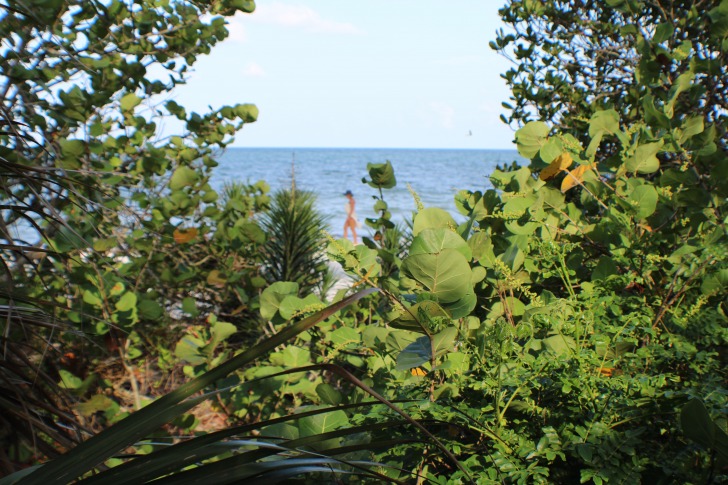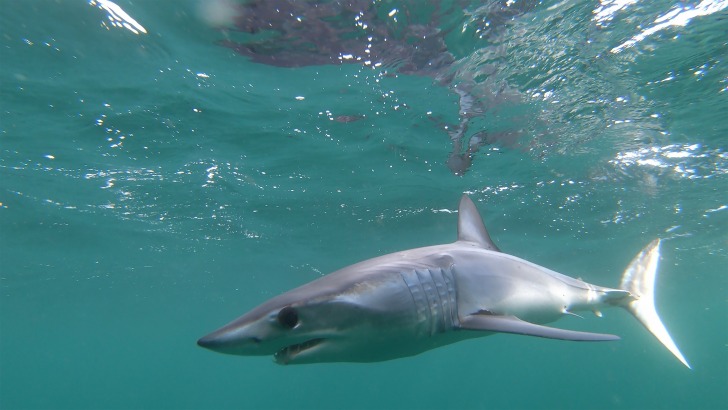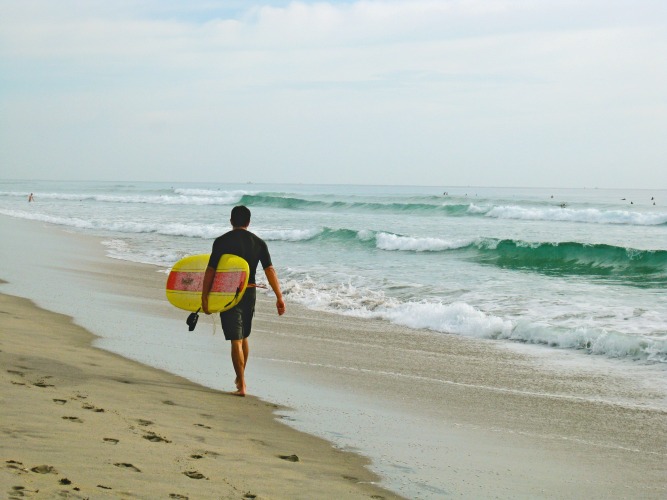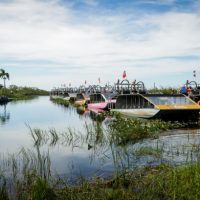Florida, also known as The Sunshine State, is the southern state in the United States.
It’s marked with several beautiful beaches, many of them rated as Blue Flag beaches, along approximately 1,350 miles of coastline.
The state is a peninsula.
It is surrounded by water on three sides.
The oceans surrounding Florida include the Straits of Florida, the Atlantic in the east, and the Gulf of Mexico.
These waters are home to an array of aquatic life including sea turtles, mammals, dolphins, whales, countless fish, etc.

Contents
- So… Are There Sharks in Florida
- Shark Species in Florida
- Blacktip shark (Carcharhinus Limbatus)
- Spinner shark (Charhinus Brevipinna)
- Sandbar shark (Carcharhinus Plumbeus)
- Blacknose Blacknose shark (Carcharhinus Acronotus)
- Nurse shark (Ginglymostoma Cirratum)
- Lemon shark (Negaprion Brevirostris)
- Sharpnose Sharpnose shark (Rhizoprionodon Terraenovae)
- Scalloped hammerhead shark (Sphyrna Lewini)
- Bonnethead shark (Hyrna Tiburo)
- Is it Safe to Swim in Florida?
- Interesting Shark Facts in Florida
- Sharks in Freshwater VS Saltwater
- 3 Safety Tips for Swiming in Shark-infested Waters
- Summary
- Florida Safety Overview
- Frequently Asked Questions
So… Are There Sharks in Florida
Yes! Florida’s waters are infested with sharks!
The question shouldn’t be if there are sharks in Florida, but rather, how many different species of shark call Florida’s warm waters home?
The temperature of the ocean around the coast of Florida is approximately 80 °F (27 °C) throughout the summer.
The water is consistently warm along the coast of Florida with minor differences in degrees from one beach to the next.
Even in the winter time, the water just off the coast of Miami is approximately 72 °F (22 °C).
This makes Florida the ideal year-round destination for sharks.
The warm water on the coast around Florida is what mainly attracts the various shark species to Florida.
Sharks prefer warmer waters from 72 degrees Fahrenheit and up.
There’s a very simple reason for this.
Sharks are cold-blooded.
They rely on warm water to regulate their body temperature.
Another attraction for sharks, in this region, is the availability of prey.
Florida is home to a wide range of sea life, including menhaden, sardines, mullet, etc.
Their typical travel routes are inshore and more northwards during the summer and spring months.
During the winter, they can be found more to the south and offshore.
Florida has some of the most shark-infested waters in the United States.
However, just because there are many sharks in the coastal regions of the state, does not mean that all these sharks are dangerous.
Many of the sharks in the list below feed off other sharks, fish, crustaceous, etc.
Some are too small to even pose a threat to humans.
There are nine species of shark that are common to the coast of Florida:
Blacktip shark (Carcharhinus Limbatus)
This shark is identified by the black tip on most of its fins, with the exception of the anal fin.
It is found in Florida and the Bahamas and is most notable as the “hit and run” shark when it comes to shark attacks on humans.
These sharks will occasionally come inshore to prey on Spanish mackerel.
These sharks grow to eight feet in length.
Spinner shark (Charhinus Brevipinna)
This shark is a fast-swimming shark and has a slender, large body.
You’ll often see it jumping out of the water in a spinning motion.
It mainly feeds on fish like herring and sardines.
These sharks grow to six feet in length and are often found inshore.
Sandbar shark (Carcharhinus Plumbeus)
This shark is known to be a predator and scavenger.
It is typically found at the bottom of the ocean, nearshore, feeding on fish and shellfish.
It grows to between six and eight feet in length and often migrates to Florida in the winter as part of a school of sharks.
Blacknose Blacknose shark (Carcharhinus Acronotus)
This is one of the smaller shark species, growing to be approximately five feet in length.
It is often the prey of larger species of shark.
They are usually of little threat to humans.
Nurse shark (Ginglymostoma Cirratum)
These sharks can be found lying on the bottom of the ocean and typically hide under wrecks and ledges.
They can be dangerous to humans if they are agitated.
They are valued in the Caribbean for their hides.
They are easily identified by their yellow-brown color.
Lemon shark (Negaprion Brevirostris)
These sharks are typically found in the coastal waters of southern Florida.
They are yellow-gray in color.
An interesting fact about these sharks is that they often enter estuarine waters.
They may even travel in freshwater, but not as far as the bull shark.
This species of shark is relatively small and only grows to about four to five feet in length.
They are often found in bays and estuaries and are inshore sharks.
They will typically feed on small fish and crustaceans.
Scalloped hammerhead shark (Sphyrna Lewini)
Scalloped hammerhead sharks are considered to be predatory.
Their meal of choice is fish, stingrays, and squid.
These sharks can be as short as six feet and grow to be as large as 20 feet.
Bonnethead shark (Hyrna Tiburo)
You’ll find these sharks in abundance in nearshore Florida.
They mainly feed on crabs and other crustaceans.
They are the smallest of the hammerhead shark family and only grow to be around three to four feet in length.
Is it Safe to Swim in Florida?
Many people travel to the beautiful beaches of Florida from all over the world.
But the waters are infested with sharks. Not all sharks that live in the coastal region of Florida are dangerous to humans.
Many of these shark species won’t attack unless provoked or may even attack as a “mistaken identity”.
This means that they may confuse humans for prey, attack, and then quickly retreat.
Swimmers should practice reasonable caution when swimming in the ocean in Florida.
Always swim in groups and only swim in areas designated for swimming.
Only swim if there are lifeguards present.
And, keep an eye out for shark warnings.
But, sharks aren’t the only threat to be concerned about.
There are rip currents in the ocean that can easily pull you out to sea.
Furthermore, there are jellyfish that sting and can leave you with a nasty burn.
But, aside from these dangers, many people frequently go to the beaches in Florida.
And, while there are lifeguards on duty and warning signs for swimmers to practice caution while swimming, shark attacks do still occur.
Not all shark attacks in the state are fatal.
As previously mentioned, there are some sharks that are known to attack humans in cases of mistaken identity.

Interesting Shark Facts in Florida
One of the shark species that didn’t make it onto our shark species list is the Great White shark.
These sharks are present in Florida waters as well.
While we only listed about nine common shark species that are typically present in the coastal regions of Florida, there are many more species of sharks that visit this region of the United States.
Sharks also do not have bones.
Their skeletons are actually quite delicate and made of cartilage and connective tissue.
This helps the shark be more flexible and helps when they are hunting prey as they can quickly turn and move swiftly in the water.
Their bodies are also much lighter as a result.
Another disturbing and yet interesting fact is that sharks do not sleep.
Ever.
The reason for this is that sharks need to keep swimming to breathe and thus stay alive.
Another interesting fact is that sharks have their own distinct personalities.
There are studies that actually confirm that sharks behave differently according to their individual personalities.
Sharks typically prefer saltwater.
Sharks need the salt from the salt water to stay alive.
Sharks must retain the salt in their bodies.
Without the salt, their cells would rapture, would start to bloat, and would eventually die.
Furthermore, according to the Smithsonian, sharks don’t have a swim bladder.
This is an organ found in most bony fish that is filled with gas and helps the fish float.
They do, however, have very large livers that do provide the sharks with some buoyancy.
It’s this buoyancy that helps them stay afloat.
In freshwater, though, sharks are much less buoyant.
In addition, sharks prefer water of a certain temperature.
The salt content in saltwater makes it seem that the salt water is warmer than freshwater.
There are some sharks that have adapted to swimming in brackish and freshwater, like the bull shark.
3 Safety Tips for Swiming in Shark-infested Waters
Avoid swimming in water where there are a lot of seals.
Sharks hunt seals.
If there are a lot of seals in the water, there is a high likelihood that there are sharks present in the water.
The danger here is that the splashing in the water may make humans resemble seals to sharks swimming below the surface.
It would simply be a case of mistaken identity.
Most sharks won’t attack unprovoked.
But, they may mistake humans for prey.
Do not splash or make big movements in the water.
Sharks may also mistake this for prey, even if there are no seals present in the water.
It’s important to be familiar with the area or to at least do some research into a body of water before swimming in it.
Sharks are more prominent in certain types of water.
You want to be sure to avoid this water at all costs.
Never go into shark-infested water if you are bleeding.
Sharks have a keen sense of smell.
They may become very aggressive when they smell blood and see thrashing in the water.
Summary
Florida is known for its year-round pleasant temperatures.
The water around the state is no exception.
It’s because of the diverse wildlife and warmer temperatures of the ocean, that Florida attracts a host of different shark species throughout the year.
Florida, in fact, is one of the shark capitals of the world.
Though not all the sharks that swim in the waters around the state are dangerous or pose a threat to human safety.
But, there are exceptions, like the bull shark and the Great White shark, who are both extremely dangerous and well-known for many attacks on humans throughout history.
Florida Safety Overview
READ THE FULL REPORT: Florida Safety Review
Safety Index:
- OVERALL RISK: MEDIUM
- TRANSPORT & TAXIS RISK: MEDIUM
- PICKPOCKETS RISK: MEDIUM
- NATURAL DISASTERS RISK: MEDIUM
- MUGGING RISK: MEDIUM
- TERRORISM RISK: HIGH
- SCAMS RISK: MEDIUM
- WOMEN TRAVELERS RISK: LOW
Frequently Asked Questions
Have there been any fatal shark attacks in Florida?
Florida is the US state where the most shark attacks occur.
The state sees approximately 29 shark attacks each year.
There have been about 23 fatal shark attacks in Florida from 1910 to the present.
Can you swim if you are on your period?
There are reports that state that it is fine to swim during that time of the month.
However, it may still be a bit risky.
Sharks have a very keen sense of smell and their behavior is dramatically altered when they smell blood.
What month has the most shark attacks in Florida?
September sees the most shark attacks in Florida.
Since 1926, of the 646 shark attacks in Florida that were unprovoked, 17% of these attacks occurred in September.
How common are shark attacks in Florida?
Shark attacks are fairly common in Florida as the state sees approximately 29 shark attacks each year.
Not all shark attacks are fatal.












Florida’s warm waters and diverse sea life make it an ideal location for sharks to thrive.
Sharks are present in Florida’s coastal regions due to its warm waters and abundance of prey, but not all species pose a threat to humans.